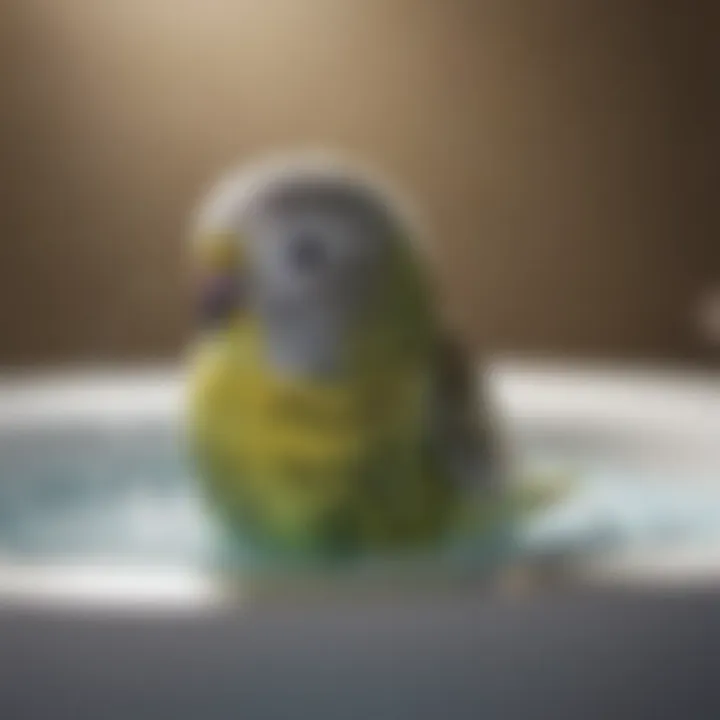Bathing Budgies: A Comprehensive Care Guide


Intro
Bathing is a vital aspect of budgie care. Understanding their bathing habits enhances the well-being of these vibrant birds. Regular bathing not only maintains physical hygiene but also promotes mental health. This guide explores various aspects of bathing practices for budgies, such as their natural behaviors, benefits, techniques, and post-bathing care. It targets pet bird owners, aspiring bird parents, and bird breeders who aim to provide the best care for their feathered companions.
Care Tips
Daily Care Routines
Budgies thrive on consistency. Establishing a daily care routine is crucial. This routine should include feeding, social interaction, and bathing. Observing your budgie during these activities can help identify preferences. Provide opportunities for them to bathe regularly, ideally every few days, depending on their individual needs.
Cage Setup and Maintenance
A well-set-up cage can encourage bathing. Ensure the cage is spacious enough and includes proper perches. Offer shallow dishes filled with clean water for bathing. Clean the cage regularly to avoid bacteria build-up. Change water daily to keep it fresh and hygienic.
Hygiene and Cleaning Practices
Maintaining hygiene is essential for budgie health. Regularly clean your budgie's bathing area. Use mild soap or vinegar and rinse thoroughly. Avoid chemical cleaners that can be harmful. Clean any toys or perches that your budgie interacts with frequently. This practice helps prevent illnesses.
Seasonal Care Adjustments
Budgies may require different care depending on the season. In summer, they may enjoy more frequent baths due to heat, while in winter, avoid cold drafts. Adjust the frequency of bathing based on temperature and humidity levels. Ensure availability of warm water during colder months to support their bathing needs.
Behavioral Insights
Understanding Bird Body Language
Recognizing a budgie's body language is essential for proper care. Signs of contentment include fluffed feathers and chirping. Conversely, a budgie may indicate stress with ruffled feathers or a low posture. Understanding these cues helps create a better bathing experience.
Common Behavioral Issues and Solutions
Some budgies may resist bathing. This can stem from fear or unfamiliarity with water. Introduce bathing gradually and use positive reinforcement. Offer treats or praises when they approach the water. Over time, this can help them feel more comfortable.
Positive Reinforcement Techniques
Rewards can effectively encourage desired behaviors. Use treats like millet or fresh fruits as incentives during bath time. Continuously reward your budgie for interaction with water. This connection can foster a more positive relationship with bathing, making it a part of their routine.
Social Interaction Needs
Budgies are social creatures; thus, they benefit from interaction. Engage with them during bath time to build trust. A calm presence can influence their comfort around water. Make sure to focus on establishing a friendly environment that supports their bathing activities.
Nutrition Guides
Understanding budgie nutrition supports overall health, which in turn enhances their bathing experience. A balanced diet contributes to healthy feathers and skin. Regularly assess their diet to ensure they get the nutrients they need.
Essential Diet Components
A well-rounded diet includes seeds, pellets, fruits, and vegetables. Offer a variety of foods to prevent monotony. Fresh, organic produce is ideal for nutrients. Avoid over-reliance on seeds, as they can lead to issues.
Safe and Toxic Foods
Awareness of safe and toxic foods is crucial. Safe options include carrots, spinach, and apples. Toxic items like avocados, chocolate, and caffeine should be strictly avoided. Always research new foods before introducing them to your budgie's diet.
Supplements and Treats
Occasional treats are good; however, moderation is key. Look for bird-safe treats that support their health. Supplements can enhance nutrition, especially during molting. Consult with an avian vet before starting any supplements.
Feeding Strategies for Different Species
Different budgie species may have varied dietary needs. Knowing the type of budgie you have aids in creating a tailored feeding plan. Research each species’ specific requirements to ensure comprehensive nutrition.
Wellness and Health
Wellness checks are paramount to maintaining a budgie's health. Regular assessments can lead to early detection of potential health issues.
Routine Health Checkups
Schedule regular checkups with an avian vet. Monitoring your budgie’s weight, feathers, and behavior can help identify problems early. Proper care includes vaccinations and preventative treatments.
Identifying Symptoms of Illness
Stay vigilant for signs of illness. Common indicators include lethargy, changes in droppings, or a ruffled appearance. Addressing these symptoms quickly can prevent more serious health issues.


Preventative Care and Vaccinations
Preventative care plays a significant role in health maintenance. Keep vaccinations current and follow advice from your vet regarding health screenings.
Mental and Emotional Well-being
A healthy mind is essential for budgie care. Provide toys and social interaction to prevent boredom. Regular mental stimulation impacts their overall emotional health positively.
Enriching Activities
Enrichment is crucial for a happy budgie. Engage them in various activities to keep their environment stimulating.
Toys and Playtime Ideas
Incorporate a range of toys into their cage. Rotate toys regularly to maintain interest. Toys that encourage foraging skills can also be beneficial.
Training and Tricks
Training stimulates both mind and body. Basic tricks like step-ups can be enjoyable for both the budgie and the owner. Keep training sessions short and positive.
Outdoor Activities and Interaction
Weather permitting, outdoor time can enhance their well-being. Fresh air and natural sunlight offer enriching experiences that support health. Ensure safety by monitoring surroundings and avoiding potential dangers.
DIY Projects for Mental Stimulation
Consider creating DIY toys or puzzles. These projects can challenge your budgie mentally while being cost-effective. Materials like paper, cardboard, and safe wood can be used in construction.
Remember: A well-cared budgie is a happy budgie. Regular bathing, nutrition, and enrichment enhance their quality of life.
Engaging in proper care practices ensures a fulfilling relationship with your budgie. Each aspect discussed contributes to the overall health, behavior, and happiness of these small, intelligent birds. By understanding their needs, you provide the best care possible.
Understanding Budgie Hygiene
Keeping budgies healthy requires a strong understanding of their hygiene needs. Regular bathing is an essential part of maintaining their overall well-being. It not only helps to keep their feathers clean but also contributes to skin health and mental stimulation. Many pet owners may overlook the significance of proper bathing routines. Understanding these aspects can greatly enhance the life quality of budgies.
The Importance of Bathing
Bathing is crucial for budgies for several reasons. First, it plays a key role in removing dust, dirt, and excess oil from their feathers. These materials can accumulate over time, affecting feather quality and potentially leading to skin issues. A clean budgie is a healthy budgie.
Furthermore, bathing helps in preening and maintaining the integrity of their feathers. It allows budgies to spread natural oils from their skin, promoting waterproofing and insulation. This is particularly important for their flight capability. Regular bathing also provides an opportunity to monitor their physical condition, helping owners to spot any abnormalities early.
Natural Habits of Budgies
In the wild, budgies are known for their instinctual bathing behaviors. They often enjoy water sources like shallow ponds and puddles to bathe. This natural instinct should be mimicked in a domestic setting. Budgies may also engage in behaviors such as splashing and playing in water.
Understanding these natural habits can guide owners in creating a comfortable bathing routine. This includes selecting appropriate bathing tools and environments. Mimicking their natural conditions can reduce stress and encourage relaxation during bathing times. Therefore, it is essential for pet owners to respect these inherent practices when bathing their budgies.
Benefits of Regular Bathing
Bathing is essential for budgies. It directly contributes to their overall well-being. Regular bathing promotes a variety of beneficial outcomes that pet owners should notice and prioritize. This section will unpack the specific advantages related to feather health, skin health, and mental wellness. These benefits enhance not just the physical appearance but also the mood and behavior of your budgie.
Maintaining Feather Health
Budgies have feathers that require proper care. Regular bathing helps to keep feathers clean and in good condition. Clean feathers maintain their ability to insulate and repel moisture.
- Prevention of Feathers' Damage: Dirty feathers can become damaged due to built-up dirt and oils. This can lead to feather picking, which some birds engage in due to irritation.
- Natural Preening: Bathing facilitates the natural preening process. This allows budgies to realign their feathers and keep them healthy.
- Hydration: When wet, feathers are softer and easier to straighten. This is vital for the birds to maintain their sleek appearance and effective insulation.
Taking steps to bathe your budgie regularly will help maintain their feather condition and health.
Promoting Skin Health
Bathing directly benefits the skin of budgies. By engaging in regular bathing sessions, you promote optimal skin condition. Healthy skin is crucial for overall health and prevents a host of potential issues.
- Cleaning Pores: Dirt can block skin pores and may lead to infections. A regular bath ensures that the skin stays clean.
- Reducing Irritation: Bathing helps to reduce dryness and irritation. This is especially important in dry conditions that budgies may face in households.
- Moisture Levels: Budgies, like many birds, benefit from hydration. Moist skin contributes to overall skin health and vitality.
Thus, bathing ensures that your budgie remains comfortable and healthy.
Enhancing Mental Wellbeing
The impact of bathing goes beyond just physical care. Mental health is equally important for budgies. Regular bathing can reduce stress and promote a calm demeanor.
- Playfulness: Budgies often enjoy water. Bathing provides an opportunity for play and enjoyment. This interaction enhances their overall happiness.
- Routine: Establishing a bathing routine can also create a sense of security. Knowing when to expect a bath provides stability in their environment.
- Bonding Time: Bathing can serve as a bonding experience between pet and owner. This interaction promotes trust, leading to increased mental wellness for your budgie.


Establishing regular bathing routines positively influences the mental health of your budgie, enhancing your bond while ensuring their well-being.
Bathing Techniques for Budgies
Understanding the proper bathing techniques for budgies is crucial for any bird owner who wishes to promote their pet’s overall health and happiness. Regular bathing not only helps in keeping the feathers and skin clean but also contributes to a budgie's mental stimulation. When considering how to introduce bathing to your budgie, it is essential to select the right technique that best matches the bird's comfort and personality.
Types of Baths
Shallow Bowls
Using shallow bowls is one of the most traditional methods of providing a bath for your budgie. The key characteristic of shallow bowls is their low depth, allowing budgies to easily enter and exit without feeling overwhelmed by water. This can be a beneficial choice because many budgies naturally engage with water in this way, as they would in the wild.
A unique feature of shallow bowls is their accessibility. Owners can readily fill them with clean water and place them in a safe, designated area. This method ensures that the bathing experience remains low pressure for the bird. However, a disadvantage is that some budgies may splash too much water outside the bowl, which can lead to messiness in the surrounding area.
Misting
Misting involves lightly spraying your budgie with water using a spray bottle designed for this purpose. This technique is valuable as it replicates natural rain, which is enticing for many birds. Misting is particularly appealing for budgies that may be hesitant to immerse themselves in water.
The unique feature of misting is its gentleness. The fine droplets create a comforting and soft experience for the budgie, promoting relaxation. On the downside, the effectiveness of misting may vary based on how much the individual bird enjoys this method. Some budgies may not respond positively and prefer other bathing options.
Shower Baths
Shower baths involve placing your budgie in the shower with you, allowing the bird to enjoy a light spray of water from the showerhead. This method can be enjoyable for both the owner and the budgie. The key characteristic of shower baths is the control it provides over the amount of water exposure.
A unique feature of shower baths is that they can simulate natural bathing conditions more closely than other techniques. The sound and sensation of running water may appeal to many budgies. However, it can also be overwhelming if the bird is not accustomed to a bathing environment like this. Proper supervision is necessary to ensure the bird's safety.
How to Introduce Bathing
Introducing bathing to your budgie should be done gradually. Start by letting your bird observe the bathing area without water. Then, allow it to explore the chosen bathing method without any pressure. Always ensure it is a safe and comfortable environment. Gradually encourage your bird to engage by demonstrating or gently placing it near the water.
Tips for a Successful Bathing Session
- Supervise Carefully: Always keep an eye on your budgie during bathing to ensure safety.
- Choose the Right Time: Avoid times when your bird may be stressed or tired. Bathing should be a positive experience.
- Positive Reinforcement: Use gentle words or rewards after a successful bathing session to encourage confidence.
- Maintain Cleanliness: Ensure that all bathing equipment is clean and free from harmful substances.
Remember, each budgie is unique. Pay attention to their response and preferences to make bathing a delightful routine.
Optimal Bathing Conditions
Creating optimal bathing conditions for budgies is essential for their overall health and wellbeing. The right environment can make bathing a pleasant experience for your pet bird, addressing both their physical and psychological needs. Properly managed bathing conditions do not only enhance hygiene but also prevent stress and health problems associated with unsuitable bathing methods.
Water Temperature and Quality
Water temperature is one of the key factors that can influence a budgie's willingness to bathe. Generally, lukewarm water is considered ideal, allowing the budgie to feel comfortable. Water that is too cold can make a budgie wary of bathing, while extremely hot water could be distressing. It is advisable to test the water with your wrist or elbow to ensure it is neither too cold nor too hot. Water quality also plays a vital role. Clean, fresh water is crucial. Avoid using tap water that contains high levels of chlorine or other chemicals. Instead, consider using filtered or purified water to ensure your budgie’s safety.
- Lukewarm water is best for comfort.
- Avoid cold or hot water to prevent distress.
- Use filtered or purified water for improved health.
Timing and Frequency of Baths
Understanding when and how often to bathe a budgie is just as important as how to create a comfortable environment. Seasonal changes affect a budgie's bathing needs. In warmer months, a budgie might enjoy more frequent baths as their feathers become dirtier from increased activity. A general rule is to allow for some form of bathing every few days in good weather. However, during winter, it may be better to limit bathing. Bathing should be done during midday when indoor temperatures are more stable, avoiding colder morning or evening hours, which might make them feel uncomfortable.
- Warm weather: Every 2-3 days.
- Cold weather: Adjust frequency as need.
- Midday is the ideal time for comfort.
Bathing at the right time and frequency helps ensure your budgie remains clean and healthy.
By considering these optimal bathing conditions, pet owners can significantly enhance the bathing experience for their budgies, thereby promoting their health and happiness.
Common Mistakes to Avoid
Understanding common mistakes when bathing budgies is crucial for maintaining their health and happiness. Pet owners often make errors leading to stress for the bird or even health issues. It is essential to be aware of these mistakes to create a safe and effective bathing routine. Below are some key mistakes to avoid.
Improper Water Levels
One common mistake is not checking the water levels before a bath. Budgies have different preferences and abilities when it comes to water depth. Too much water can be intimidating and lead to drowning. A shallow layer of water, typically around one inch, is ideal. This allows the budgie to bathe comfortably without the risk of accidents. If the water depth is incorrect, the bathing experience may become stressful rather than enjoyable for the bird.
Using Soap or Detergents
Another significant error is using soap or detergents in the water. Budgies have sensitive skin and feathers. Chemical products can cause irritation, skin issues, or allergic reactions. Even small traces can be harmful. Instead, clean water, free from any additives, is the safest choice. A regular rinse of water is enough to keep their feathers clean. Ensuring that the bathing area and implements are free from residues is equally important to prevent accidental contact with these harmful substances.
Forcing the Budgie to Bathe
Lastly, forcing a budgie to bathe presents a major problem. Some budgies may not enjoy the water or need time to get used to the idea. Pressuring them can lead to fear and aversion to bathing altogether. It is essential to make baths optional, allowing the budgie to explore the water on its terms. Creating a positive atmosphere around bathing can help the budgie associate it with a pleasant experience instead of stress. This gradual approach helps build trust and encourages a healthier bathing habit.
Remember: Making mistakes is part of learning, but understanding these common errors can greatly enhance your budgie's bathing experience.


Potential Risks and Precautions
Bathing budgies can be an enjoyable activity that contributes to their well-being. However, it is essential to be aware of the potential risks and necessary precautions that can help ensure safety during this process. Understanding these elements is crucial not only for the bird's physical health but also for its mental and emotional stability. It is not simply about the act of bathing; it involves creating a healthy and stress-free experience for your pet.
Overexposure to Water
One of the primary concerns when bathing budgies is the risk of overexposure to water. While budgies naturally enjoy water, excessive soaking can lead to several health issues. Prolonged exposure to water can disrupt their body temperature regulation. Budgies may struggle to dry themselves thoroughly, which can result in cold or even hypothermia, especially in environments with cool drafts. It is crucial to monitor the duration of bathing sessions to ensure they are brief.
Additionally, overexposure can lead to conditions such as fungal infections. Wounds from injuries can worsen when a budgie is consistently wet, allowing bacteria or fungi to thrive. Therefore, ensuring that the bathing experience remains supervised and limited in time is important. A few minutes in a shallow bowl or misting with water can be sufficient. Consistent bathing habits should not compromise your budgie's safety.
Health Concerns Related to Bathing
Bathing, while beneficial, can also lead to various health concerns if not approached with care. Budgies that are ill or have existing medical conditions may not handle bathing well. In such cases, it is advisable to consult a veterinarian before introducing bathing routines. Sick budgies tend to have weaker immune systems, making them more vulnerable to infections after exposure to water.
Another health concern relates to the use of non-natural bathing substances. Always avoid soaps, detergents, or human shampoos, as these can irritate the budgie's skin and feathers. It is best to use clean water for bathing purposes. Furthermore, after bathing, closely observe your bird for any signs of distress or illness. If anything unusual is noted, contacting a veterinarian immediately is wise.
Post-Bathing Care
Post-bathing care is crucial for the overall well-being of budgies. After a bath, a budgie needs proper attention to ensure it retains the benefits gained from the bathing process while also avoiding health-related issues. Proper drying techniques are key to maintaining feather condition and preventing cold or wet stress. Each method of drying has unique advantages and considerations that pet owners should be aware of to make informed choices for their feathered friends.
Drying Techniques
Natural Drying
Natural drying is a simple yet effective technique. Budgies often shake themselves after bathing, which helps remove excess water. This method allows the bird to maintain its natural behavior and comfort. One key characteristic of natural drying is that it does not involve any external force or assistance. This makes it a gentle choice for the budgie, promoting a sense of security.
Natural drying's unique feature is that it allows the budgie to fully engage in its natural instinct. While it may take longer for the feathers to dry completely, the risk of overheating or stress is significantly lower. However, in cold environments, this method might not be the best option as it could lead to the budgie getting chilled.
Using Towels
Using towels is another drying technique that can be quite popular among budgie owners. This method involves gently blotting the budgie with a soft towel after its bath. It allows for quicker drying than natural methods and gives the owner more control over how wet the budgie remains.
The key characteristic of using towels is the speed at which a budgie can dry off. It can be especially beneficial during colder months when quick drying is essential to avoid health complications. A unique feature of this method is that it requires close interaction between the owner and the bird. While this can strengthen the bond, owners must be cautious not to apply too much pressure, which could cause distress to the budgie.
Heat Lamps
Heat lamps can provide a warm environment for drying after a bath. This technique is effective for drying a budgie quickly while ensuring it does not get chilled. The key characteristic of heat lamps is that they provide a consistent and gentle warmth, creating a safe space for the budgie.
One unique feature of heat lamps is their adjustable height and intensity, allowing owners to customize the drying experience based on their bird's needs. However, there are disadvantages to this method too; if not set up correctly, heat lamps can lead to overheating or discomfort. Owners must monitor their budgie closely when using this technique to ensure it remains safe and comfortable.
Monitoring Health After Bathing
After bathing, it's vital to monitor the budgie’s health for signs of distress or illness. Observing the bird post-bathing can uncover any potential issues early on. Considerations include keeping an eye on feather condition, activity levels, and signs of respiratory distress. Regular checkups will help ensure that your budgie remains healthy and happy throughout its bathing routine.
When Not to Bathe Your Budgie
It is crucial to recognize the times when bathing your budgie is inadvisable. Bathing is an essential practice for maintaining the health and hygiene of these birds; however, it must be performed under appropriate conditions. Certain situations can pose risks to the well-being of your budgie, making it necessary to postpone or avoid bathing altogether. Understanding these circumstances will help you prevent potential harm and create a safe environment for your pet.
Sick or Injured Budgies
Bathing a budgie that is sick or injured can exacerbate their condition. When a bird is unwell, its energy levels drop significantly. Exposure to water can lead to additional stress. Birds in such states may not have the strength needed to dry themselves properly, increasing their vulnerability to illness.
If your budgie shows signs of sickness—such as lethargy, fluffed feathers, or changes in appetite—consider postponing bath time. Instead, focus on providing comfort and monitoring their health. Consult a veterinarian if you have concerns about your bird's condition. Bathing should only resume once your budgie is fully recovered and its energy levels have returned to normal.
During Extreme Weather Conditions
Another time to avoid bathing your budgie is during extreme weather conditions. High humidity or cold temperatures can greatly impact a budgie's ability to regulate its body temperature. When it is particularly hot, bathing can cause sudden temperature shocks if the water is too cold. Conversely, during cold weather, damp feathers can lead to chilling, which may cause respiratory issues.
In extreme conditions:
- Hot Weather: Provide a shallow bowl with cool, clean water, but limit the time your budgie spends in it.
- Cold Weather: Avoid bathing altogether. Instead, keep your budgie in a warm environment and ensure they have access to clean, dry perches.
Always prioritize your budgie’s comfort and health. If the weather is not suitable, it is better to wait.
This understanding of appropriate bathing conditions is crucial for maintaining your budgie's health and happiness. Delaying bathing in these scenarios can prevent unnecessary stress and health complications, ensuring your pet remains comfortable.
End
In this article, we emphasized the vital importance of proper bathing practices for budgies. Regular bathing is not merely hygienic; it plays a crucial role in the overall well-being of these birds. Owners may overlook this aspect, but recognizing its significance can prevent health issues in the long term. This conclusion serves to reiterate the key elements covered, the benefits of frequent and proper bathing, and the considerations pet owners should keep in mind.
Summary of Key Points
The discussion throughout this guide centered on several core points:
- Hygiene Maintenance: Bathing helps remove dirt, dust, and feather debris. This directly contributes to feather vitality and the bird's overall cleanliness.
- Skin Health: Regular interaction with water prevents dry skin conditions and promotes better skin hydration.
- Mental Enrichment: Bathing is a natural behavior and offers mental stimulation to budgies, allowing them to exhibit instinctual actions.
- Specific Techniques: We explored various techniques like using shallow bowls, misting, and shower baths, providing options tailored to different pet bird preferences.
- Optimal Conditions: Understanding water temperature and the appropriate timing for baths ensures a stress-free experience for the budgie.
- Avoiding Mistakes: Knowing common errors such as improper water levels or subjecting a bird to soap can save potential harm.
- Post-Bathing Care: The correct drying methods and health monitoring is essential post-bath.
- When to Refrain from Bathing: Being informed about when not to bathe helps in protecting the budgie's health.
Encouraging Healthy Habits
To foster a culture of healthy bathing habits for budgies, owners must take proactive steps:
- Observe Reactions: Pay attention to the budgie's response during bath time. If they seem stressed, reevaluate the technique or conditions being used.
- Establish a Routine: Create a consistent bathing schedule based on observed preferences and behaviors, which can help the budgie feel familiar and comfortable during bath time.
- Use Safe Products: Ensure any tools or bath additives are bird-safe. Avoid using soaps or chemicals that can cause irritation.
- Educate Yourself: Continuously learning about budgie care can enhance your ability to provide an enriching environment. Resources like Wikipedia, Britannica and relevant discussions on Reddit can offer valuable insights.
- Connect with Community: Engage with other budgie owners through platforms like Facebook or online forums. Sharing experiences can lead to improved care techniques and supportive advice.
As this guide reflects, through understanding and implementing appropriate bathing practices, budgie owners can significantly enhance their pet's quality of life, ensuring they are not just living, but thriving.















